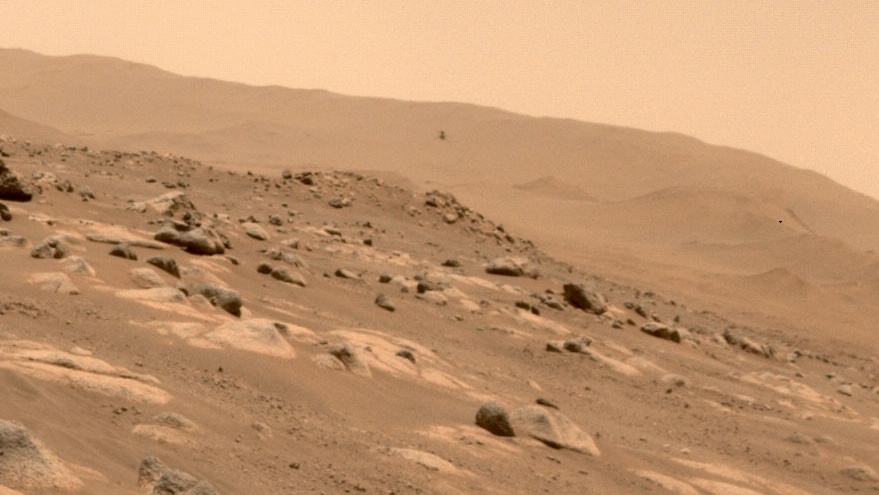WASHINGTON — With four flights now complete, NASA’s Ingenuity Mars helicopter will transition from being strictly a technology demonstration to a test of its ability to work in cooperation with the Perseverance rover.
Ingenuity performed its fourth flight April 30, staying aloft for 117 seconds. The helicopter flew to an altitude of 5 meters, then went 133 meters downrange and back before landing. The flight set records for duration in the air and distance traveled.
The flight was scheduled for April 29, but telemetry returned later that day showed that the helicopter never took off. Project engineers believe that a timer issue, similar to one discovered during a preflight test in early April, kept the helicopter grounded. They developed a way to get around the timer glitch without updating the helicopter’s software, a method they previously said should work 85% of time the time.
“There is a bug, and this is a workaround for the bug,” Bob Balaram, Ingenuity chief engineer at the Jet Propulsion Laboratory, said during an April 30 press conference about the helicopter shortly before data confirming the successful flight arrived on Earth. “It worked out perfectly well three times and yesterday it didn’t quite work.”
The successful fourth flight now allows Ingenuity to move into a new phase of its mission. NASA originally planned to conduct up to five test flights over a campaign lasting 30 sols, or Martian days, after which the project would end, no matter the state of the helicopter. That would allow the Perseverance rover, supporting the helicopter flights, to move on to its primary science mission.
However, at the JPL briefing, agency officials said Ingenuity would continue to operate beyond the original month. “After assessing the Perseverance science strategy, there’s room to expand the Ingenuity demonstration into a new phase,” said Lori Glaze, director of NASA’s planetary science division. “Ingenuity is going to transition from a technology demonstration, where we prove the technical capabilities of the helicopter, to an operations demonstration.”
In that new demonstration, Ingenuity will support Perseverance as it starts its science mission. “We will now concentrate on the utility of an aerial platform, and work on operational products,” said MiMi Aung, Ingenuity project manager. That would include aerial observations of science targets for the rover and scouting paths for the rover to take.
That effort will start with the helicopter’s next flight, expected in about a week. The project team will use images taken on the fourth flight to identify a new “airfield,” or landing spot, for Ingenuity. The helicopter will then take off on a one-way flight from its current landing zone to the new one, which will be the base of operations for the next phase of the mission.
The extended mission is made possible in part because of the excellent performance of Ingenuity. “The technical performance has been fantastic, and exceeding all of our expectations,” Balaram said. “We had in our mind that there would be some issues.” The only issue, he said, was the timer glitch.
He noted the solar-powered helicopter has no consumables that would limit its life. The biggest issue is likely thermal stresses from the day-night cycle on Mars affecting commercial off-the-shelf parts used on the helicopter. “The expectation is that, at some point with enough thermal cycling, something — a joint or something — will snap,” he said.
The other major factor that allowed the extended mission is a change in plans for Perseverance itself. “Originally, we thought we would be driving away from the location that we landed at,” said Jennifer Trosper, Perseverance rover deputy project manager. Instead, scientists want to remain in the area for months, including collecting the first samples the rover will cache for later return to Earth.
Ingenuity operations will be limited, though, during this operational demonstration to minimize the effect it has on Perseverance. While Ingenuity had been flying every three to four days, the mission now expects to perform only one or two flights over the next month, once the helicopter flies to its new airfield. Perseverance also won’t be taking images of the helicopter in flight as it had on previous flights.
“We are hoping we can operate Ingenuity in a not-to-interfere basis with the science mission, in a way that, as long as it’s available and alive, that we’ll be able to continue,” Trosper said.
That operational demo is scheduled to last 30 sols, but NASA is open to continuing it for longer if the helicopter remains in good condition and is helping Perseverance. “We’re going to watch the performance, we’re going to see the kind of data products that we can get back, and see how the two flight systems work with each other,” Glaze said. “After that 30-sol period, we’ll assess where we are.” Glaze added the extended mission will have only a “very minimal” cost given the reduced pace of operations.
“We really do expect some finite life” for Ingenuity, Aung said, “so it will be a race between how long these parts surprise us in surviving and, in doing these operational scenarios, we will naturally be pushing the limits of Ingenuity.”
